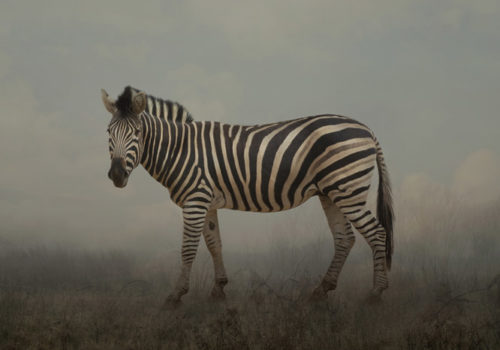Looking at the work of Durer, Rembrandt and Stubbs led to an interest in the apparent disconnection between animals and their habitat. How artists had historically represented animals which they might not have seen, or not seen in ‘the wild’ made me question what a natural habitat actually meant. There is an apocryphal story that George Stubbs saw a lion killing a horse in North Africa on his way back from Italy, but this is unlikely to be true. His painting of a zebra (1763), which he saw in a private menagerie, is placed in what looks like a North European woodland. The painting appears perfectly balanced and correct although the animal is in a habitat with which it is not normally associated.
Reflecting on these historical works led to thoughts about native and alien species, and what it means to be indigenous. There is an assumption that where things are, is where they belong, and a belief that native is good and alien is bad. Sometimes people appear to interpret the terms, native and alien, to suit their own particular prejudices.
Somewhere I imagine a voice saying, ‘Surely if it is attractive and there aren’t many of them it must be native?’ All the animals in this series were photographed in a studio or in a studio set-up where the animals lived. They were positioned against a neutral background and lit with a combination of ambient and artificial lighting. The intention of using this technique was to give the animals a simultaneous feeling of both separateness and togetherness with the environment, into which they would be subsequently positioned.
Different animals posed different challenges. I was told by the zebra keepers that they didn’t think it would be possible to construct a background in front of which the animals would stop to be photographed, as zebras, are known to be very twitchy. But the keepers were willing to try. On their advice, we built a mini studio in the zebra area. Over a period of 4 weeks, the zebras slowly became familiar with the set up and after that 4 weeks and regular visits, Stella the Zebra, gave me 5 minutes of photographic time! Other animals were more compliant, such as Moccas, the Andean Condor, who turned up where I work, with Adam, his handler, in an estate car, out of which he hopped out and walked alone into the studio.
The landscapes were made from combinations of landscapes layered in different degrees of opacity. Sometimes the landscapes were made from works made in the same place but from different viewpoints and at different times. Other landscapes were made up from places that relate to each other on some level. When I look at the land, I ask myself, what is special and unique about this place? Where is it comparable with? What other places make me feel like this?
And out of these thoughts evolve the landscapes that have found their way into this series. For example one landscape is part-Oxford, where I live, part-Islay, which I visit regularly and part the Australian Outback where I have travelled.
Although this collection of images is a series, each animal and each landscape has provoked individual questions and excitement and has led to a unique dialogue to which I have tried to respond.
This series of work would not have been possible without the support of many people. I would like to thank Reggie Heyworth, Jamie Craig and all the keepers at Cotswold Wildlife Park. Adam Bloch and Holly from the International Centre for Birds of Prey at Newent. Jurg and Bianca Olsen at Jukani Wildlife Sanctuary. Sias van Rooyen, Debbie Young and the keepers at Knysna Elephant Sanctuary. Tammy, Craig and the keepers at Cango Wildlife; Jo Vestey and Melissa Stockdale for great advice and hospitality and finally Miranda Creswell for constant love and encouragement.
EXHIBITION
Long Ago and Far Away
Rory Carnegie
From April 21st to May 21st, 2016
John Martin Gallery
38 Albemarle Street
London W1S4JG
United Kingdom
[email protected]
http://www.jmlondon.com
















